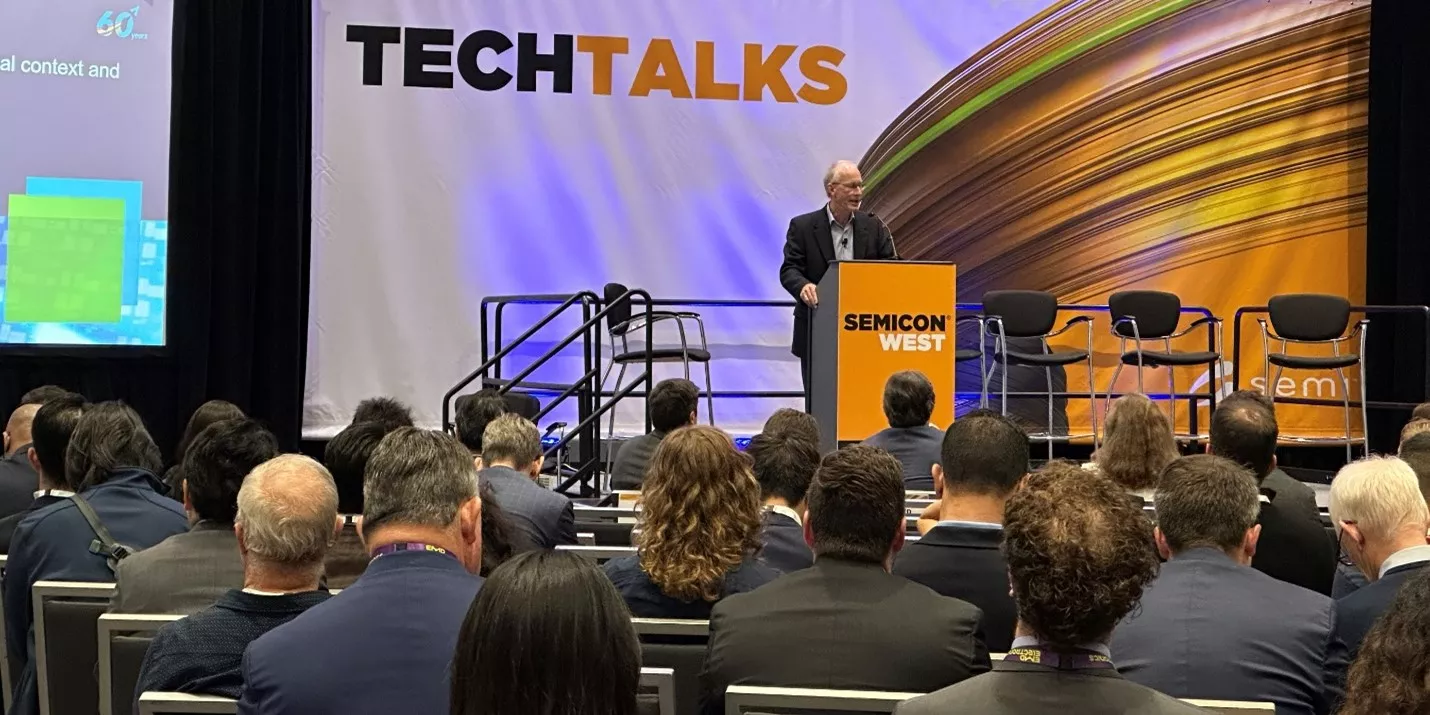
At SEMICON West 2023, a panel of experts discussed the growing legal and regulatory risks facing the semiconductor industry and how to navigate those risks through the pursuit of sustainability strategies and broader industry collaboration on policy development.
Panelists included Ben Siegl, Flurospecialities Business Manager at Arkema; Lu Gan, Director of R&D Sustainability at EMD Electronics; Scott Stone, President and Founder of Glencoe Strategies; and Colin Brough, Product Compliance and Advocacy at TEL. The panel was organized by the SEMI Electronic Materials Group (EMG).
The panel concluded by proposing a call to action for the semiconductor industry to develop a comprehensive, integrated policy proposal that could become the basis of a new regulatory framework for the industry. The aim of the framework would be to clarify transition timelines, highlighting technology innovation needs and mitigating regulatory risks in a way that achieves greater overall environmental performance without clashing with economic priorities.
Signs of Growing Regulatory Risk
Over the past month, global average surface temperature, North Atlantic sea surface temperature, Antarctic sea ice depletion, and Canadian wildfires have exceeded all previously recorded highs.
This is likely to change the climate policy debate from one based on climate modeling (i.e., what experts think might happen in the future) to one based on climate data (i.e., what has already happened and impacted everyone negatively). The data is so recent that current and prospective climate regulatory requirements do not yet reflect the elevated sense of urgency such experiences will inspire in progressive policymakers or provoke politically among the general public.

Colin Brough addresses a full conference room at SEMICON West.
But in the near term, this will increase the regulatory risks facing the semiconductor industry and require greater cohesion and clarity on industry-wide sustainability standards and goals.
The leadership demonstrated to date by many individual companies on sustainability is impressive but does not, by itself, insulate the industry from regulatory risk – with some possible regulatory outcomes likely to be at odds with existing technological capabilities and commercial realities.
Regulatory Standards for the Semiconductor Industry
The United States and the European Union are both phasing down the production and import of hydrofluorocarbons (HFCs) pursuant to the Kigali Amendment to the Montreal Protocol. These and other HFC-related requirements will significantly constrain the upstream supply of HFCs over the course of this decade and beyond and limit, on an application-by-application basis, the types of HFCs that may be used based on their Global Warming Potentials (GWPs).
Although the U.S. Environmental Protection Agency (EPA) allocates a portion of the application-specific allowance pool directly to the semiconductor industry, that policy is temporary, and the industry would have to justify the policy every few years. More generally, fabs can expect increased pressure on controlling/recycling emissions during the etching process.

Many HFCs have GWPs in the thousands. Proposed U.S. and EU regulations would prohibit GWPs greater than 300 to 700 in the coming year and are likely to ratchet down further to GWP thresholds of 150 and, in some applications, 10.
Other greenhouse gases used in the semiconductor industry, such as N2O, PFCs, SF6, and NF3, are not directly regulated in the United States, though both EPA and states such as California possess varying levels of authority to constrain their use and emissions.
By contrast, the EU’s proposed F-Gas Regulation covers a wider scope of fluorinated compounds, including HCFs, PFCs, HFCs, HCFCs, HFEs, SF6, NF3.
The F-Gas proposal, which is currently under final negotiation between the EU Parliament and the EU Council, is likely to become law by the end of 2023. The proposal sets strict quota phase down requirements, restrictions on servicing and maintenance of existing equipment that will result is some forced obsolescence, and a range of market prohibitions which target a GWP of less than 150 by 2030 for most air conditioning and refrigeration equipment. Low temperature refrigeration equipment (chillers), typically used in etch and prober applications, are likely to be exempted, but the final outcome remains uncertain.

In addition to climate change considerations, growing concerns about the presence of PFAS in many fluorinated compounds is fueling additional uncertainty, with some U.S. States (e.g. Maine and Minnesota) and some bodies in the EU calling for near-term restrictions of PFAS-containing chemicals.
The semiconductor industry also profiles as an energy-intensive and water-intensive industry, which can figure in the reporting and disclosure of Scope 1 (direct emissions), Scope 2 (indirect emissions, such as from energy use), and Scope 3 (emissions from the supply chain). Both U.S. and EU authorities are seeking to require greater disclosure of at least Scopes 1 and 2 emissions and may eventually clarify Scope 3 standards to the point where those emissions might be required in disclosures as well.
Sustainability Leadership in the Supply chain
The panel also highlighted existing efforts by individual companies and by the industry as a whole to demonstrate leadership on climate and broader sustainability goals. Many companies in the supply chain, including chip manufacturers, equipment manufacturers and material suppliers, have pledged greater than 50% emission reductions by 2030 and carbon neutrality by 2050.
These commitments are important because supply chain companies are singularly capable of determining the technical and economic feasibility of implementing measures to reduce emissions in the byzantine process of manufacturing chips. While these pledges signal technical viability to achieve neutrality, they don’t forestall regulatory intervention that could hinder the industry’s technology roadmap.
 Companies willing to commit to shrinking their climate footprint play an essential role in providing detailed steps to reduce emissions in a way that does not interrupt supply or innovation of critical electronic devices.
Companies willing to commit to shrinking their climate footprint play an essential role in providing detailed steps to reduce emissions in a way that does not interrupt supply or innovation of critical electronic devices.
To be most effective, the semiconductor industry should look to act collectively through collaborative touch points such as SEMI and SIA. Members of these industry associations are already establishing leadership positions in sustainability, but must also solicit cooperation from suppliers, competitors, and customers to work collaboratively with regulators to achieve a practical path to more sustainable chip manufacturing.
Chip Industry Must Develop Integrated Standard
Semiconductor manufacturers, equipment and materials suppliers, and end users are unlikely to be able to continue to rely on voluntary commitments – or even geostrategic considerations for advanced microelectronics – to shield the industry from future climate-driven regulatory requirements. The industry’s technical sophistication is such that progressive policymakers will push for standards irrespective of the industry’s technological capabilities and commercial realities.
This makes it imperative for the industry to devise its own integrated standard capable of exceeding the environmental performance of whatever might be imposed under existing law, drawing as applicable on the successful track record and industry-friendly institutions of the Montreal Protocol for examples, structures, and concepts.
About the Authors
 Scott Stone is President and Founder of Glencoe Strategies focusing on legal and consulting work on climate change and conservation policy, with special focus on domestic legislative, regulatory, and political issues and international treaty negotiations relating to hydrofluorocarbons (HFCs) and other fluorinated compounds and their substitutes. Scott was the original drafter of the American Innovation and Manufacturing Act of 2020 (AIM Act) and helped secure the U.S. Senate vote in favor of ratifying the Kigali Amendment to the Montreal Protocol.
Scott Stone is President and Founder of Glencoe Strategies focusing on legal and consulting work on climate change and conservation policy, with special focus on domestic legislative, regulatory, and political issues and international treaty negotiations relating to hydrofluorocarbons (HFCs) and other fluorinated compounds and their substitutes. Scott was the original drafter of the American Innovation and Manufacturing Act of 2020 (AIM Act) and helped secure the U.S. Senate vote in favor of ratifying the Kigali Amendment to the Montreal Protocol.
 Dr. Colin Brough is in Product Compliance and Advocacy at Tokyo Electron Europe Ltd. Dr. Brough joined the semiconductor equipment industry in 1994 following a career in magnetic material research, product development in consumer products and process development for military defense equipment. Over the 28 years in the semiconductor industry, his job roles have included Customer Support, Process Support, Technical Training and EHS. With the growing demands on the industry resulting from environmental regulations, particularly within the European Union, he moved into Product Compliance and Advocacy. As part of the Tokyo Electron Global team, he addresses the impacts of proposed regulations worldwide, working together with other industry partners and SEMI.
Dr. Colin Brough is in Product Compliance and Advocacy at Tokyo Electron Europe Ltd. Dr. Brough joined the semiconductor equipment industry in 1994 following a career in magnetic material research, product development in consumer products and process development for military defense equipment. Over the 28 years in the semiconductor industry, his job roles have included Customer Support, Process Support, Technical Training and EHS. With the growing demands on the industry resulting from environmental regulations, particularly within the European Union, he moved into Product Compliance and Advocacy. As part of the Tokyo Electron Global team, he addresses the impacts of proposed regulations worldwide, working together with other industry partners and SEMI.